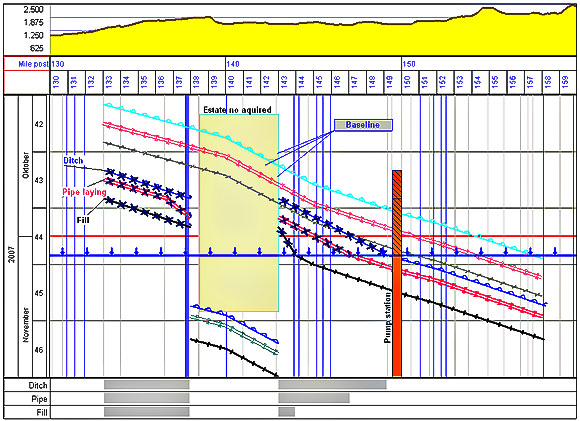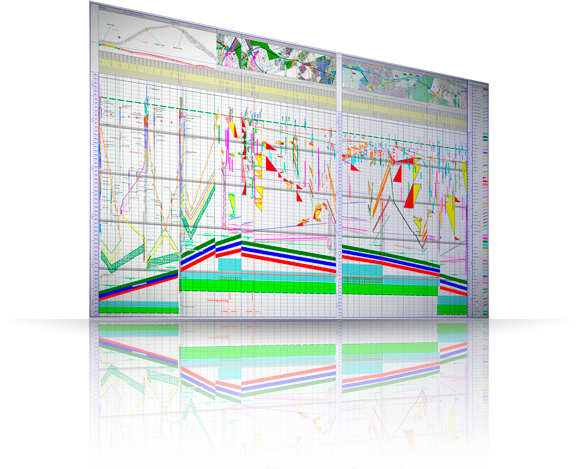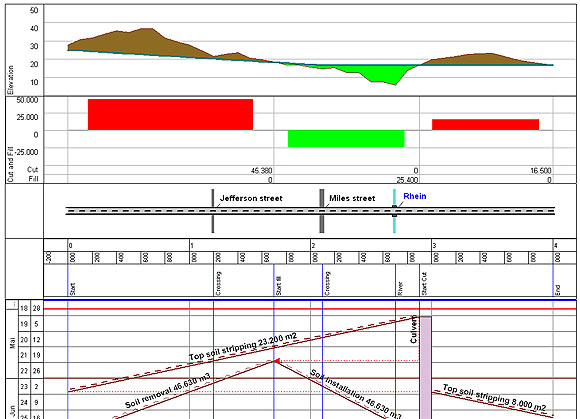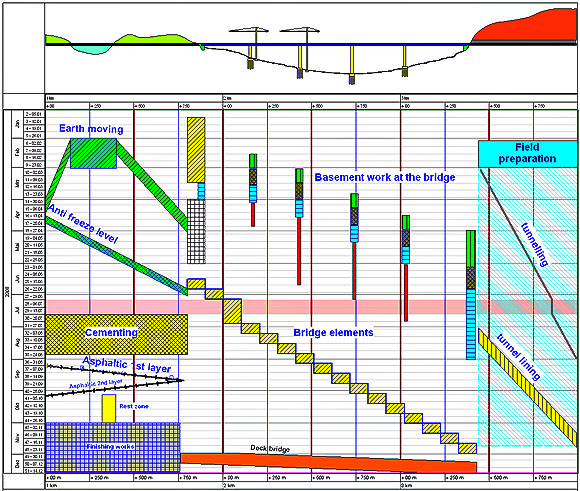TILOS – Time Location System
TILOS is a time-location planning software for managing linear construction projects, basically infrastructure projects.
TILOS is
-
Easy to use, yet powerful.
-
Utilized on many international projects.
-
Bi-lingual customer help desk.
-
Simply a brilliant tool for planning and managing linear projects.
The Linear Scheduling Method
TILOS was developed to improve visualisation of repetitive tasks when planning and managing major projects. The time-distance diagram supports all highway, rail, tunnel, pipeline and bridge projects.
The key benefits of TILOS is the flow of visual data in terms of time and place on one plan. CPM schedules and network diagrams are more analytical, but they fail to provide a visual connection between the project plan and the project itself.
Each country has different names for this specific planning technique:
-
Linear Scheduling Method (LSM)
-
Time Distance Diagram
-
Time Location Diagram
-
Time Chainage
-
French Diagram
-
March Chart

How do I read a linear schedule?
Linear schedules can communicate more information because of the way distance related data is assigned to each individual task. The link between site and schedule information enables a quicker and deeper understanding of the construction plan.
-
The distance axis is typically horizontal and the time axis is vertical (although this can be reversed). Furthermore, the slope of the task line indicates the speed or productivity rate of the crew performing the work in the field.
-
Task lines that overlap indicate possible pitfalls and show that the construction plan does not work.
-
Non-linear activities, where the crew is stationary, are represented by block tasks. Examples include block valve installations, road bores or bridge foundation work.
-
Restricted areas do not allow the planning of tasks in a given time and distance window because of permitting issues preventing land access or environmental issues (such as bird areas or rare plants). Clash detection highlights which tasks collide with one another.


Site related data such as elevation and crossing lists help you understand the schedule and to identify constraints. Most data is available well before scheduling work is started. TILOS can import this data and increase the information communicated along with the plan while reducing the effort of re-entering data multiple times.
-
Symbols and pictures can be imported and placed along the distance axis to describe the work that has to be performed in the project.
-
Scales and grids describe important station points. Grid lines assigned to stations also simplifies data entry.
-
Speed profiles model non-linear productivity rates in different sections of the project such as: slope areas, wetlands, heavy rock areas or simply base productivity on learning curves.
-
Distance related graphs such as: elevation, slope diagrams or mass haul profiles showing cut and fill sections can be generated directly from profile data.
How do I keep my plan up to date?
In most project management systems progress is defined on actual dates and % complete, while the % value is often estimated. TILOS can record progress for each task based on site data and show exactly which sections of the project have not been completed.
-
Progress can be recorded in three methods: percentage based, work based or distance based. In all cases precise location information where the work has been completed is required. This progress can be shown with a simple distance based bar chart, showing completed sections.
-
The remaining work can be re-evaluated to meet the project goals. This can be done by increasing resources or making changes to the construction plan.
-
The baseline shows differences between plan and execution and highlights delays in the project at an early stage.
-
The progress data can be imported from the daily site reports into TILOS. A flexible import feature reads the data from Excel files and assigns the progress directly to the activities, analyzes the results and updates the remaining work program.



TILOS is designed for fast creation of linear schedules making use of predefined work packages in its library. On creating new activities, TILOS is analysing location data (length) and can immediately set quantity, resource allocation and duration. The planning work is reduced to a minimum.
-
Drawing on screen: The most natural way is to develop the plan graphically on screen, like you would do on paper. TILOS converts the lines into real time and di-stance data. Changes in dialog are converted directly to the drawing.
-
Activity list: Create first a list of work packages and edit the distance values manually or by sector list. They appear automatically in time distance view. The sector list is a table with predefined location areas, where work will be executed.
-
Bar chart: Draw activities directly in the bar chart, like you know from other applications.
-
Import: Activity lists with links and resources can be imported to TILOS and viewed as a time distance diagram. Missing information can be added later in TILOS.
-
Insert activity groups: Pre modelled activity groups, that are always performed in one sequence can be generated in one action (e.g. Trench opening – Pipe laying – Trench filling).

-
Drawing on screen: The most natural way is to link the activities directly on screen using the mouse.
-
Link List: Get a good overview on the links structure by simply creating and editing them within a list.
-
Import: Import allows the quickest way of creation, if those have already been worked out in a CPM based planning system.
TILOS has many unique features to reflect the effect of the field location into the schedule such as:
-
:
Set a distance, that 2 activities need to have in between, and TILOS will adjust this on each reschedule (e.g. Trench opening needs always to be 100 m ahead of Pipe laying).
-
:
This option makes sure, that 2 linked activities are always synchronised in location, if source activity is changed (e.g. if length of trench opening is updated, then end of pipe laying gets updated as well).
-
:2 Processes work parallel and have the same speed. TILOS makes sure, that if the speed of master activity is changed, all others also get changed.
-
:If two teams work at the same work package but from different side with different speed. TILOS calculates the meeting point automatically by setting an end-end-link.
Downloadable White Papers:
User Reviews:
“TILOS transformed our engineers’ attitude toward project scheduling from something extra they never had time for to a tool they “owned” and wouldn’t go to a meeting without.”
– James Lyon from HDR Inc. in USA
“I appreciate that the TILOS team continuously improves this application and also listens to the client for improvement, so please continue on this level.”
– Geert Bijmolt from NACAP in Netherlands
“For linear projects, there is nothing better!”
L.P. Project Manager South Africa
“Awesome piece of software with many applications in the job.”
– Stuart Shortland, Planner, Parsons Brinkeroff Ltd, UK

REQUEST A QUOTATION
-
ProjectPro provides best-in-line local support and services (implementation and consultancy).
-
ProjectPro offers formal software training and free hands-on workshops.






